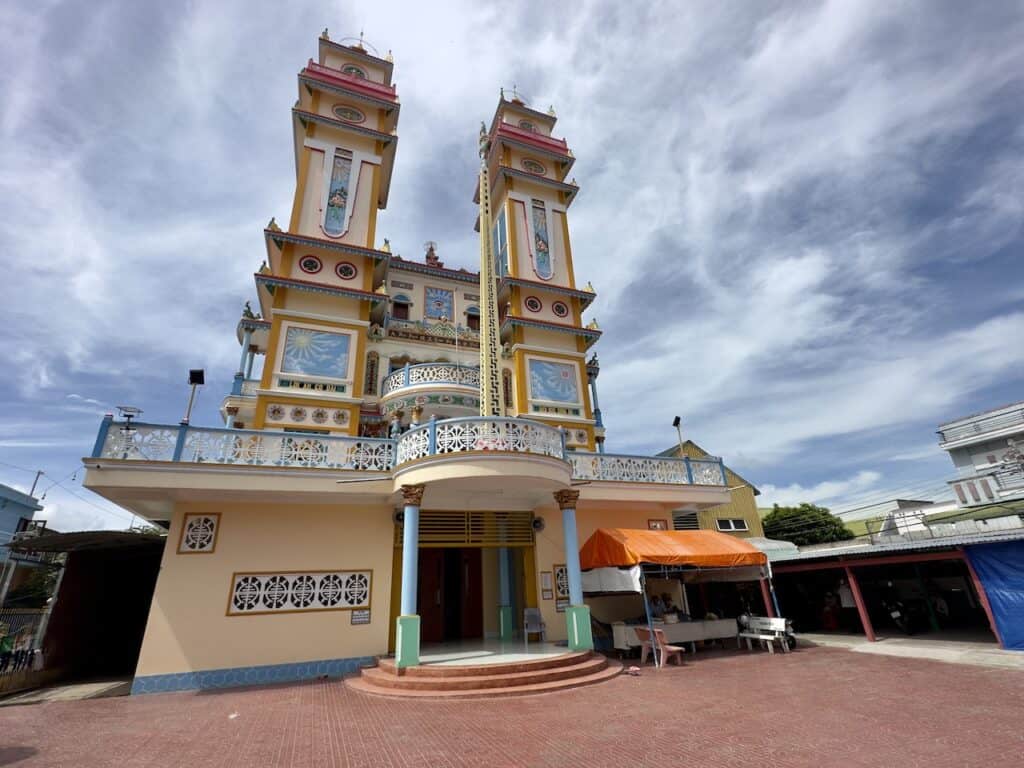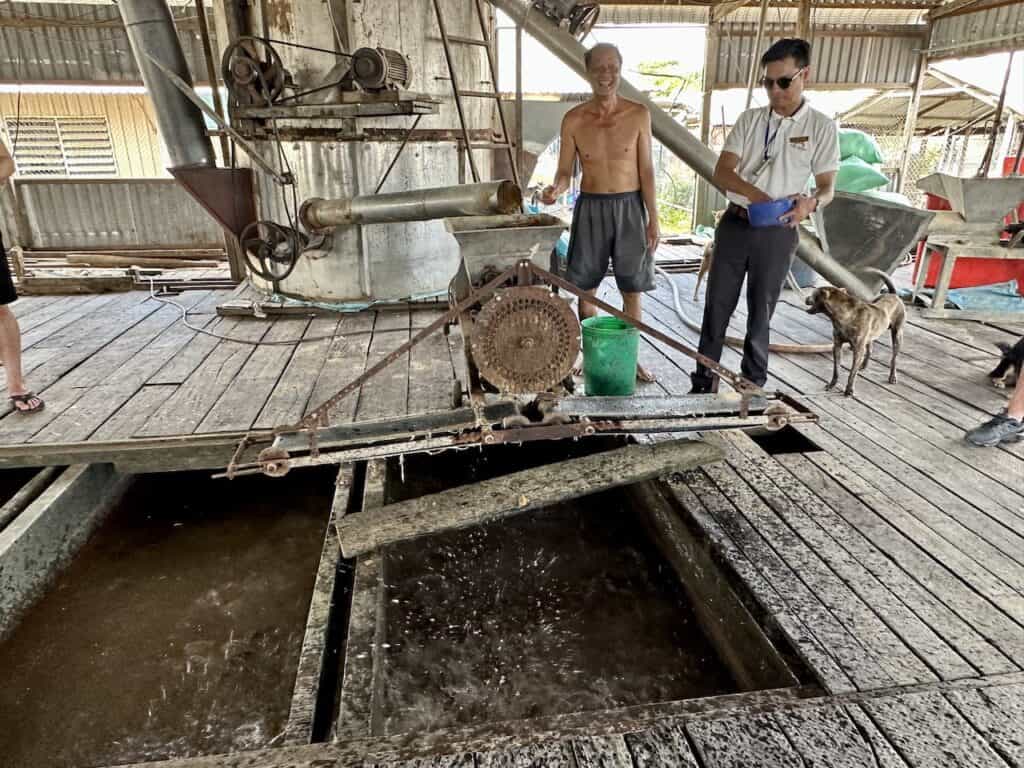Tan Chau, Vietnam: on the Mekong River
Tan Chau (official spelling: Tân Châu) is a district located in the An Giang Province of Vietnam. It is situated in the Mekong Delta region in the southern part of Vietnam.
The area is known for its fish farms, agriculture, markets, and very friendly people.
Traditionally, it’s spelled “Tân Châu,” but since many computer keyboards don’t typically have accents readily available, the headings on this blog will go without them. I apologize for the inconsistencies below!
The Basics: Visiting Tan Chau
Tân Châu is situated in the southwestern part of Vietnam, near the border with Cambodia. It is approximately 250 kilometers (155 miles) west of Ho Chi Minh City (formerly Saigon) and is easily accessible by road or waterways.
The drive from Ho Chi Minh City will take about 5 hours on the roadways.
Vietnam: An Giang Province
Vietnam’s An Giang Province is made of mostly flat and fertile terrain, which is typical of the Mekong Delta. The landscape consists of rice paddies, rivers, canals, and lush greenery. The Hậu River (Bassac River) and various tributaries of the Mekong flow through An Giang.
Agriculture
Like much of the Mekong Delta, Tan Chau is predominantly an agricultural region. The fertile delta soil supports the cultivation of rice, fruits, and various vegetables. Fishing is also a main source of income.
Silk Production
Tan Chau is famous for its traditional silk production. The district is known for its skilled weavers who produce beautiful silk fabrics and garments.
Cultural Heritage
Tan Chau is home to various ethnic communities. Visitors can explore temples, pagodas, and traditional festivals that reflect the cultural tapestry of the area.
Where to Stay in Tan Chau, Vietnam
There are a few hotels and rental options in this area. They’re incredibly affordable!
You can use the interactive map below to plug in your dates and look at the availabilities:
The Tan Chau Market
While tourism is growing in Tan Chau, and many Mekong River cruises stop here, the market in town is far less “touristy” than other markets you’ll visit in Vietnam.
The vendors don’t actively approach visitors, pushing their products. Instead, they’ll just give you a very friendly “hello” as you walk by, and answer any questions you have.
- Market Hours: 5:00 am – 5:00 pm (daily)
The produce section included more exotic fruits and vegetables than I’ve seen at any market anywhere! The fruits in several bushels were totally new to me.
The market is technically a “wet market,” since fruits and vegetables are sold, along with live seafood and other animals, like chickens.
Tan Chau’s market is divided into different areas:
- Vegetables & Fruits
- Fish
- Meats
- Live Fowl
- Rice & Noodles
- Spices & Seasonings
- Housewares
- Clothing
- Jewelry
- Flowers
- Wedding & Funeral Supplies
The funeral supplies, by the way, include fake money which is burned (instead of real cash) as the Vietnamese bury the dead.
The market is another indicator of how important fishing is to the Tan Chau area. There are dried fish options, stacked on top of each other, which is very common in Asian markets.
They also have fresh seafood. The prawns, squid, and fish are all freshly caught in the Mekong River and its tributaries.
The fish that are uniform in size are from fish farms, while fish of varying sizes are wild-caught in the river. The wild-caught fish are more expensive.
Thánh Thất Tan Chau Temple
Thánh Thất Tân Châu is the main center of worship for the Cao Dai religion. The temple is an eccentric, colorful landmark in Tan Chau.
The temple’s architecture features a unique blend of styles, incorporating elements of Buddhist pagodas, Christian cathedrals, and traditional Vietnamese temples. The temple in Tan Chau was built 100 years ago. The vibrant primary colors are symbolic of the different religions:
- Red: Confucianism
- Blue: Taoism
- Yellow: Buddhism
Like other Cao Dai temples, Thánh Thất Tân Châu prominently displays the Divine Eye symbol, which represents the all-seeing eye of God. The Divine Eye is depicted at the center of the temple’s facade, and is also a main focal point inside.
Also inside the temple, you’ll see various animals depicted in the sculptures, designs, and paintings. They’re also symbolic in the religion:
- Dragons: Wisdom & Power
- Unicorns: Prosperity
- Phoenix: Rebirth
- Turtles: Longevity
As inclusive as the temple and religion are, men and women are still separated at times. They use separate entries, and are split into different prayer areas inside.
Cao Dai Religion
The religion of Cao Dai is a relatively modern religious movement that originated in Vietnam in the early 20th century. It combines elements of Buddhism, Taoism, and Confucianism. The name “Cao Dai” translates to “High Tower” or “High Place,” symbolizing the divine realm or supreme deity in the religion.
Cao Dai was founded in 1926 by Ngo Minh Chieu and Le Van Trung, who claimed to have received divine revelations from a higher power. They believed that Cao Dai was a unifying faith that could bring together the best aspects of different religions.
Cao Dai promotes moral and ethical values, including compassion, honesty, and humility. Followers are encouraged to lead virtuous lives and strive for self-improvement.
Ba Chua Xu Temple
The Ba Chua Xu Temple (also known as the Tây An Temple or Lady Xu Temple) is one of the most significant religious sites in the region.
The Temple is located on Sam Mountain (Núi Sam), which is 6 kilometers west of the center of town. Sam Mountain is a prominent hill in the region, and the temple sits atop it, offering panoramic views of the surrounding countryside.
Ba Chua Xu is considered a guardian spirit and a powerful deity who is believed to grant blessings and protection to her devotees. The temple is a place of pilgrimage for many Vietnamese, especially during the annual Ba Chua Xu Temple Festival, which takes place in the spring.
For Hikers: Aside from its religious significance, the temple also offers stunning panoramic views of the Mekong Delta and the surrounding countryside. Visitors often ascend Sam Mountain to enjoy the scenery.
Tan Chau Fish Farms
The Mekong River’s banks are lined with gray metal buildings, which are part of the extensive collection of fish farms in the region.
Tilapia and catfish are commonly grown in the floating fish farms here.
Each building typically sits on top of large underwater cages, which house thousands of fish. The cages run 20-meters long, and descend 7-meters deep below the surface of the Mekong.
Food at the Mekong Fish Farms
The families that run the fish farms usually make their own fish food. They use ground-up brown rice husks (called dust rice), and use sweet potatoes and other fish to create a brown paste. A machine mixes it and turns it into fish food pellets.
The fish recognize the sound of the machine, and surface in a frenzy to feed.
The fish farms also have stacks of bags of fish food. Each costs $25, so the cost adds up. They’re used at times to change up the flavor for the fish. It encourages them to eat.
Keeping the Fish Farm Healthy
If fish start floating belly-up, they’re dissected to find the problem. Tumeric and local honey are added to the food to help with digestion.
Around 100,000 fish are held in each cage, so it’s also important for the flow of the Mekong River to keep moving through and filtering the water.
Lifespan of the Fish
The fish spend nearly a year in the cages, until each fish weighs about two pounds. The market will typically pay $2 per fish.
From the fish farm, the fish are transported in special boats, which keep them alive in tanks until they’re filleted at the factory.
Mekong River Cruises
Mekong River cruises are growing in popularity, as a unique and immersive way to explore Southeast Asia. Several of them will stop in Tan Chau for a few hours.
The river cruises typically travel many miles down the Mekong, crossing international borders, and giving travelers the opportunity to visit villages, temples, and markets, in an authentic and immersive experience.
These cruises include stops at unique and less-visited destinations, like Tan Chau, allowing travelers to discover hidden gems and experience local life off the beaten path.
Mekong River cruises often feature guides onboard who give lectures, and chefs who teach about the unique cuisine in the region.
History & Background of Tan Chau
The Tan Chau region’s history is closely intertwined with the broader history of the Mekong Delta.
The area that is now Tan Chau has been attractive to settlers throughout history, including the Khmer people (native to present-day Cambodia), who brought Buddhism with them.
In the 19th century, French colonial rule dominated Vietnam. Rice cultivation became a major focus under French rule, with the Mekong Delta serving as a crucial rice-producing region.
Later, Tan Chau, like many areas in the Mekong Delta, played a role in the Vietnam War. It was involved in several conflicts, and the proximity to the Cambodian border made it strategically significant.
After the end of the Vietnam War and the reunification of North and South Vietnam in 1975, the country underwent a period of reconstruction and development. Tan Chau, like other areas, saw efforts to rebuild and improve infrastructure. Today, rice cultivation remains a primary economic activity, along with silk and fishing.
Wrap: Visiting Tan Chau, Vietnam
Tan Chau offers an opportunity to immerse yourself in Vietnamese culture, local traditions, and daily life by exploring the town’s markets, interacting with friendly locals, and trying traditional Vietnamese dishes and street food.
The area’s cultural authenticity alone is a compelling reason to visit for travelers interested in experiencing the heart of Vietnam!
Check out our other posts about Vietnam and Southeast Asia!



















